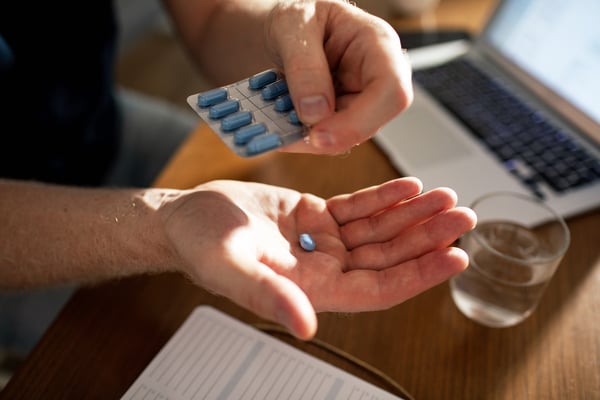Improving the Patient-Pharmacist Relationship in 4 Easy Steps
Pharmacists are the premier medication experts within health care, who understand more about medication interactions than most physicians and have the unique ability to prevent complications, improve adherence, and save lives.
Envision a patient walking into their nearest pharmacy to pick up a prescription. The experience, by nature, is fairly universal and relatable.
The patient waits in line, gives their name to the technician, receives their bag of medication, and in many instances, signs their name, remits payment, and leaves. Many questions are left unanswered, but the patient may be too reluctant to ask and the technician is likely too busy to stop and ask whether there are any questions or concerns.
This is the type of predictable and unfulfilling interaction patients and pharmacists generally expect to experience. But does it always have to be this way? Is there untapped potential in this relationship?
According to the CDC, adverse drug events (ADEs) are costing our health care system approximately 1.3 million emergency department visits a year, $30 billion in additional costs, and are considered by epidemiologists to be the fourth leading cause of death.
Many do not stop to consider how a transactional relationship between a pharmacist and patient may be hurting patients’ health and our overall health care system.1
For too long, the medication expertise and deep knowledge of pharmacists have been underutilized and underappreciated. Pharmacists are the premier medication experts within health care, who understand more about medication interactions than most physicians and have the unique ability to prevent complications, improve adherence, and save lives.
They are also included under HIPAA, so they can review comprehensive medication lists to cross-reference medication interactions. Yet, to a shocking degree, the profession currently deemphasizes these skills to the detriment of the patients who need them.
In a post-COVID world where physicians and medical staff are overstretched and burned out, pharmacists have a unique opportunity to help change this relationship for the better. Here are 4 ways to help improve the patient-pharmacist relationship.

1. Improving patient accessibility
Many patients visit pharmacies more often than their physician’s office, and a sizable number of those patients perceive the physical presence of their pharmacist as preferable. However, although visible, many barriers exist that prevent the pharmacist and patient from having a meaningful, productive interaction.
Pharmacists often appear preoccupied with their varied tasks behind the counter, making it difficult to hold a focused conversation. There can also be long lines to speak with a pharmacist, creating patient frustration, and the absence of a dedicated space makes the ability to have a private, thoughtful consultation about a personal health matter seem nearly impossible. Improving accessibility may involve encouraging pharmacists to seek alternative ways to reach patients that extend beyond the four walls of a pharmacy.
In today’s digital world, new technologies have the potential to help transform the role of pharmacist, making them accessible to patients via their smart phones. Connecting pharmacists and patients telephonically offers a more efficient way to reach patients and a more confidential and convenient way for patients to get their questions answered.
If each patient had access to a pharmacist at their fingertips for a consultation unhampered by long wait times or rushed by competing priorities in a physical setting, it would eliminate many of the barriers found at a local pharmacy. Unrushed consultations also allow pharmacists to build relationships with their patients, leading to better care over the long term.
2. Implementing a patient-centered culture
Implementing a patient-centered culture is essential to earning trust. This requires pharmacists to not only harness their deep expertise in medication management but to also be strong communicators.
By meeting patients where they are, a pharmacist can motivate and encourage them, impacting or influencing said behaviors over time. This also teaches pharmacists to recognize a patient’s intention and concerns about a health challenge and acknowledge that the decision to change a behavior is ultimately theirs.
Having productive conversations with patients involves ongoing training. All pharmacists should consider how to refine their communication skills and pursue ongoing education to ensure they foster a patient-centric culture with every interaction. This ultimately leads to a relationship built upon trust, which can impact whether a patient chooses to adhere to their treatment plans.

3. Treating the whole patient
If pharmacists were able to consolidate multiple consultations into one, imagine how effectively they could treat the whole patient. This could result in proactive identification of varying medication adherence issues, immunizations and wellness exam reminders, education around healthy behaviors, and potential interactions with non-prescription medications.
If pharmacists had the ability to take a more comprehensive approach to each patient during every visit, it is easy to imagine the gaps in treatment they would be able to identify. This approach to treating the whole patient also leads to more productive conversations between the patient and pharmacist, ultimate improvement in the patient’s health, and greater professional satisfaction from the pharmacist knowing they are making a lasting impact.
4. Staying engaged with the patient
The pharmacist-patient interaction typically ends when the patient leaves the pharmacy. If the role of a pharmacist were considered to be a long-term partnership similar to that of a patient and their primary care physician, with regular check-ins for a patient’s understanding of their medication and adherence to medication regimens, there would likely be an overall improvement in the patient’s health and satisfaction.
With physicians and nurses stretched thin, there is absolutely a seat at the care team’s table for a pharmacist to take a leading role. We’d be remiss not to mention an integral component to the pharmacist-patient relationship: the pharmacist’s own personal and professional satisfaction.
To care for others, pharmacists must also care for themselves. With the way people work shifting since the pandemic, it is now possible for pharmacists to embrace remote work and determine the patients they want to treat, the hours they want to work, and from where they choose to practice patient care. Often times, a happier pharmacist will result in a healthier patient.
Implementing the strategies above can lead to stronger pharmacist-patient relationships, gratified pharmacists, and healthier patients.
About the Author
Jennifer Cohen is senior vice president of marketing and communications for Aspen RxHealth. She is an award-winning marketing communications executive on a mission to influence and shift the paradigm of healthcare as we know it. With nearly 20 years of demonstrated experience, she brings a unique bench of skills as a speechwriter, journalist, marketing executive, and servant-style leader. She has ghostwritten for high-profile executives and served as speechwriter for Generals Norman Schwarzkopf and Alexander Haig, in addition to being a published author herself. Her work leading multi-billion-dollar organizations through times of transformation, including high-profile acquisitions, divestitures, and large-scale mergers has resulted in accolades including Top Women in Healthcare and Top Women in Communications. She currently serves as the Senior Vice President of Marketing and Communications for Aspen RxHealth, a pharmacy services startup transforming care delivery. Jennifer is driven by her passion to break down silos in healthcare and enable technology startups to experience exponential growth that simultaneously impacts the lives of patients across the nation.
Reference
1. Center for Disease Control and Prevention (CDC). Adverse Drug Events in Adults. Adverse Drug Events in Adults | Medication Safety Program | CDC. Updated October 11, 2017. Accessed October 27, 2022.
Originally posted on Pharmacy Times.